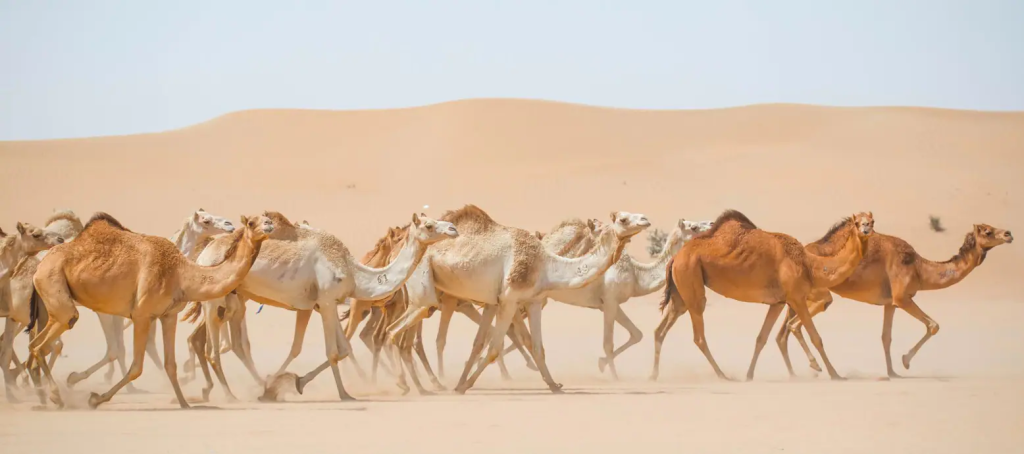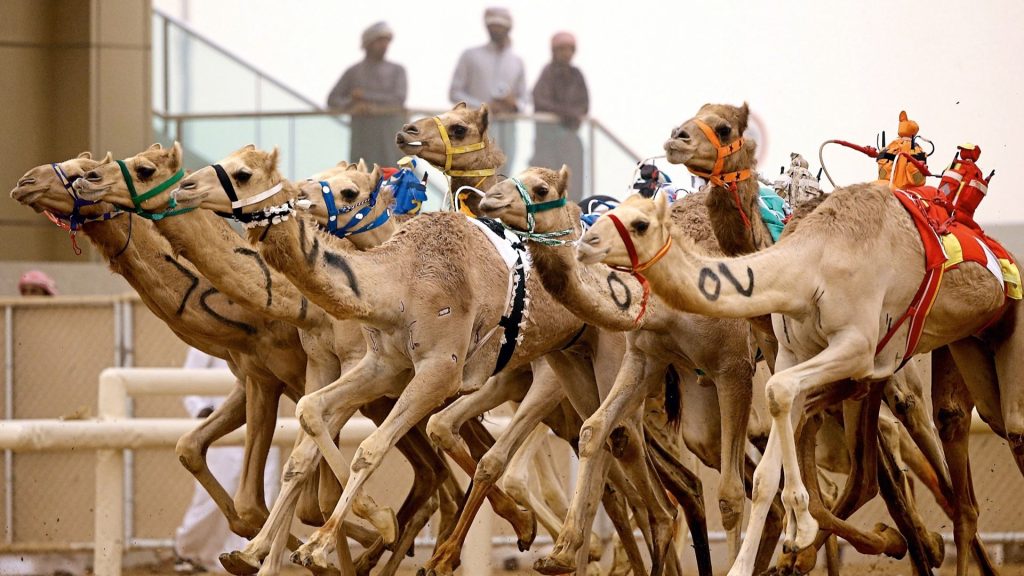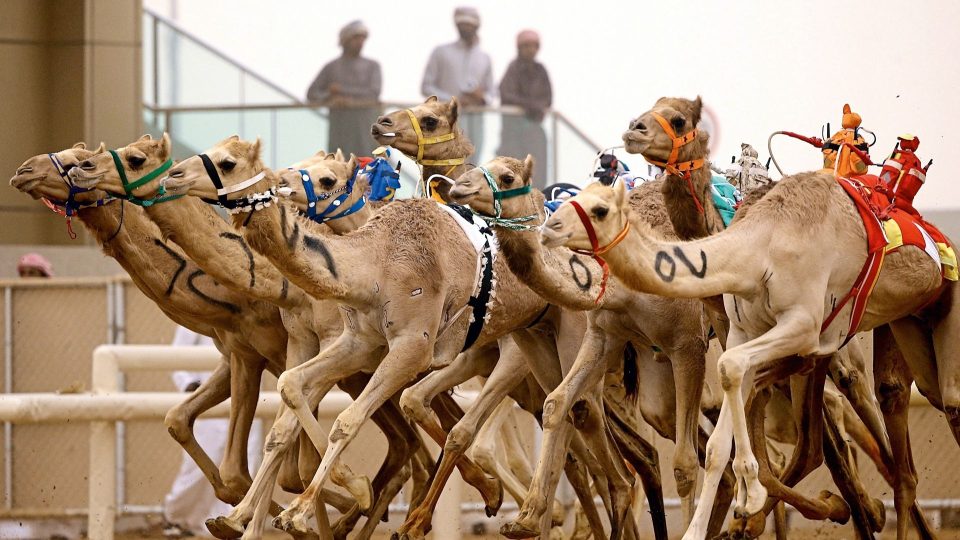Camel racing in the UAE is more than just a sport. It’s a living, breathing tribute to Emirati heritage. Picture thundering hooves across golden dunes, cheers from the sidelines, and the morning sun catching the dust kicked up by some of the most prized animals in the Arabian Peninsula. That’s not just a spectacle; it’s a cultural heartbeat.

Historically, camel racing dates back centuries to the Bedouin tribes, who raced their camels for entertainment and honour during gatherings and festivals. What began as informal races in the desert has now evolved into a regulated, high-stakes sport, complete with racetracks, official timers, breeding programs, and even robotic jockeys (more on that soon).
Why is camel racing important in the UAE? Because it symbolises values like endurance, resilience, and pride in tradition. It’s supported by the UAE government not just as entertainment, but as a way to preserve the identity of a nation racing into the future—while refusing to forget where it came from.
From sheikhs to schoolchildren, camel racing is respected as a proud part of Emirati culture—woven into the national story just as tightly as the threads in a kandura.
When is the Camel Racing Season in the UAE?
If you’re planning to catch the action live, timing is everything. Camel racing in the UAE kicks off during the cooler months, typically from October through to March. Why then? Because neither camels nor crowds enjoy sprinting under a 45°C desert sun.
This season coincides with the UAE’s prime outdoor period. Think morning races in crisp desert air, traditional music drifting in the background, and spectators sipping Arabic coffee while cheering from the stands. The atmosphere is half adrenaline, half cultural celebration.
Many of the country’s biggest races—like those at Al Marmoom Camel Race Track in Dubai and Al Wathba in Abu Dhabi—are scheduled across this window. Among the most famous events is the Al Marmoom Heritage Festival, held annually and drawing international attention (and camels worth more than most sports cars).
Whether you’re visiting for a weekend or planning an extended cultural deep-dive, the racing season is your golden ticket. It’s when tradition comes to life, tracks buzz with energy, and locals and tourists alike line the fences to watch history—at 65km/h.
Where to Watch Camel Racing in the UAE?
When it comes to camel racing, not all tracks are created equal. The UAE is home to several iconic venues where this centuries-old tradition meets 21st-century spectacle. Whether you’re in Dubai or Abu Dhabi, there’s a racetrack with your name on it (figuratively—unless you’re royalty).
Al Marmoom Camel Race Track: Dubai’s Premier Venue
If you want the crème de la crème of camel racing, Al Marmoom is your go-to. Nestled deep in the desert, just past the city’s shiny skyline, this is the largest and most famous camel racing track in Dubai.
Expect a well-organised arena, high-tech timing systems, and regular races during the season, especially in the early mornings. The track really comes alive during the Al Marmoom Heritage Festival, when camels from across the Gulf (and sometimes further afield) come to compete for glory—and serious cash.
As a spectator, you don’t need a ticket. Just show up early, grab a karak chai from a nearby stall, and enjoy the show from the stands—or watch from your car as you tail the race along the service roads.

Al Wathba Camel Race Track: Abu Dhabi’s Racing Hub
In Abu Dhabi, Al Wathba Camel Race Track is where the action is. Set in a sprawling desert landscape, this racetrack blends high-end facilities with an atmosphere that still feels authentically old-school.
The races here attract local tribes, tourists, and even royals. It’s also known for its use of robotic jockeys and state-of-the-art camel training facilities. During big festivals like the President’s Cup, prize money soars—and so does the excitement.
There’s also a Camel Racing Museum nearby, where you can learn about the evolution of the sport before heading to the track to see it live in action.
Other Notable Festivals and Regional Tracks
Outside of the big cities, regional camel races are just as thrilling—and sometimes even more charming. Races in places like Liwa (part of the Liwa International Festival – check out everything on offer from horse racing to falcon racing) and Ras Al Khaimah offer a more intimate, local experience.
These events often include other traditional competitions like falconry, horse racing, and cultural performances. If you’re after something less touristy and more community-focused, these are worth the detour.
Can You Visit a Camel Race as a Tourist?
Absolutely, and you should. Camel racing in the UAE isn’t some closed-off, VIP-only affair. In fact, it’s one of the most welcoming cultural experiences you can have as a visitor. Whether you’re a curious traveller, culture buff, or just want to watch a camel sprint like a desert Ferrari, you’re in luck.
First off, entry is usually free. That’s right — no ticket barriers or inflated tourist prices. Most racetracks, like Al Marmoom in Dubai or Al Wathba in Abu Dhabi, are open to the public, especially during major events like the Al Marmoom Heritage Festival or the Liwa International Festival.
So, what should you expect?
- Early mornings: Camel racing in the UAE typically begins around 7 a.m. Beat the sun, grab a karak chai, and enjoy the sunrise over the sand.
- Fast-paced action: Camels can clock over 60km/h. It’s surprisingly thrilling.
- A family-friendly crowd: Locals, expats, and tourists mingle together. You’ll see kids, grandparents, and even the occasional falcon perched on an arm.
- Plenty of photo ops: The mix of traditional dress, high-tech jockeys, and dusty racetracks makes for iconic Instagram shots.
- Cultural extras: At bigger festivals, expect traditional music, camel beauty contests, markets, and food stalls dishing out Emirati favourites.
How has Camel Racing Embraced Technology?
You might think camel racing is all about tradition, but don’t let the dusty racetracks and heritage vibes fool you. This sport has had a tech upgrade, and it’s pretty impressive. The UAE has masterfully fused the old and new, giving us a sport that’s as culturally rich as it is technologically advanced.
The Shift from Child Jockeys to Robots
Let’s rewind a bit. In the early 2000s, international attention turned toward the use of underage jockeys. In response, the UAE led the charge in reforming the sport by developing robotic jockeys, a world-first at the time.
Today, tiny robot riders weighing just 2–3kg perch atop racing camels, equipped with GPS systems, walkie-talkies, and even heart rate monitors. These remote-controlled jockeys are operated by trainers in SUVs alongside the track (yes, it’s as wild as it sounds—imagine a caravan of 4WDs chasing 20 camels).
Not only did this innovation improve animal welfare and rider safety, but it also propelled the UAE into global headlines for its forward-thinking approach.
GPS, Drones & Data
Tech isn’t just limited to the jockeys. Modern camel racing involves:
- GPS tracking of camels during races for real-time stats
- Drones capturing aerial footage for broadcast and replay
- Biometric monitoring to assess a camel’s performance and recovery
- Digital betting platforms (in some regional events abroad, not in the UAE, where gambling is restricted)
Some facilities—like those at Al Marmoom and Al Wathba—look more like Formula 1 pit lanes than desert arenas.
If you’re curious about the science and breeding behind elite racing camels, check out institutions like the Fujairah Research Centre, where genetics, nutrition, and veterinary care are taken to a whole new level.
The Business of Camel Racing
Camel racing isn’t just a cultural pastime, It’s a multi-million-dirham industry. Behind every galloping camel is a carefully orchestrated operation involving elite breeding programs, dedicated training, and serious prize money. If you thought horse racing was exclusive, welcome to its sandier cousin.

Racing Camels is Big Business
Top-tier racing camels are like thoroughbreds — and they’re priced accordingly. Some have been sold for millions of dirhams, especially those with strong bloodlines or a proven track record (pun intended). Buyers range from wealthy locals and Gulf royals to investors looking to back a winner.
Camels are trained daily, fed strict diets, and monitored closely. They even get regular spa treatments—think treadmills, massages, and specialist care.
Breeding and Research Centres
Institutions like the Fujairah Research Centre are leading the charge in camel genetics and performance science. These centres study everything from muscle fibre types to respiratory efficiency, all in the name of producing the next generation of desert champions.
Advanced breeding methods (including AI and embryo transfer) are now common practice, ensuring camels are not just fast, but consistent and durable across seasons.
Prize Money and Prestige
Winning a major camel race doesn’t just bring home a trophy—it can come with prize money ranging from AED 100,000 to several million. Add to that the prestige, sponsorships, and breeding rights, and you’ve got yourself a full-blown sports empire.
It’s not unusual for winners to be celebrated on local news, gifted luxury cars, or even awarded land by ruling families—this isn’t just about speed; it’s about national pride.
How to Experience Camel Racing in Dubai or Abu Dhabi?
So, now that camel racing is on your UAE bucket list (as it should be), let’s talk logistics. Experiencing a race up close isn’t hard — you just need to know when to go, where to be, and how early to set that alarm.
Best Time to Visit Dubai
Camel racing takes place during the cooler months, typically October to March. If you’re hoping to catch a big festival or high-stakes race, aim for:
- Al Marmoom Heritage Festival (Dubai) – usually in March
- Liwa International Festival (Abu Dhabi) – late December
- President’s Cup (Al Wathba) – a marquee event for breeders and owners
Races often happen in the early mornings (6–8 a.m.), so bring a coffee and embrace the sunrise.
How to Get There?
Most tracks are outside the city centres:
- Al Marmoom Camel Race Track is about a 40-minute drive from central Dubai.
- Al Wathba is around 45 minutes from downtown Abu Dhabi.
You can drive yourself, hire a driver, or join a guided tour that often combines camel racing with a desert safari, dune bashing, or a stop at a traditional souk.
What to Expect on Race Day?
- Free entry and open seating
- Crowds made up of locals, expats, and the occasional VIP
- Traditional food stalls and markets at larger events
- A chance to follow the race from your car on the parallel track — it’s chaotic and amazing
If you’re lucky, you might get chatting to a local camel trainer or even spot a royal in the crowd. The vibe is both laid-back and electric, with races lasting just a few minutes each, but leaving a lasting impression.
FAQs About Camel Racing in the UAE

If you’re new to the world of camel racing (and let’s be honest, most of us are), you’re bound to have a few questions. Here’s a quick FAQ to help you feel like a seasoned spectator.
Is it free to attend camel races in the UAE?
Yes, entry is completely free at most tracks, including Al Marmoom and Al Wathba. You don’t need a ticket, just show up early and grab a good viewing spot.
Is camel racing family-friendly?
Absolutely. You’ll find locals bringing their families, and there’s usually a relaxed, welcoming vibe. Bigger festivals like the Liwa International Festival even include petting zoos, local markets, and entertainment for kids. (Read more here)
Can tourists drive alongside the race?
Yes — and it’s one of the most unique aspects of watching a race. A convoy of SUVs follows the camels along parallel tracks, allowing spectators (and trainers) to keep pace with the action. Just make sure you’re comfortable driving in sand!
Are robotic jockeys used in all races?
Nearly all official camel races in the UAE now use robotic jockeys. These high-tech riders are controlled remotely and are part of the UAE’s push for animal welfare and technological leadership in traditional sports.
Can I visit a camel training or breeding centre?
Some tour operators can arrange visits to camel farms or breeding centres. While not always open to the public, facilities like the Fujairah Research Centre sometimes offer educational tours upon request.
Can I take photos?
Yes, photography is allowed—and encouraged. Just be respectful of locals, especially if you’re taking portraits, and avoid using flash near animals.
Learn more about Fun Facts in Dubai
Camel racing is more than a sport in the UAE
Camel racing in the UAE isn’t just about watching animals sprint through the sand. It’s about witnessing a nation’s identity in motion — where ancient tradition and cutting-edge innovation collide under the desert sun.
From the heart-thumping excitement of a sunrise race at Al Marmoom to the fascinating world of robotic jockeys and million-dirham camels, this sport tells a story. It’s a story of how the UAE honours its Bedouin roots while confidently embracing the future — not with nostalgia, but with pride and purpose.
For tourists, camel racing offers more than entertainment. It’s a window into Emirati culture, hospitality, and values. You might arrive a curious traveller, but you’ll leave with a deeper appreciation for a sport that manages to be unapologetically traditional and undeniably modern at the same time.
So whether you’re chasing camels down a track in a 4WD, sipping karak at the sidelines, or planning your next cultural adventure, make camel racing a part of your UAE story. Beyond it being a race, it’s also very much a celebration of heritage, horsepower, and the spirit of the desert.



